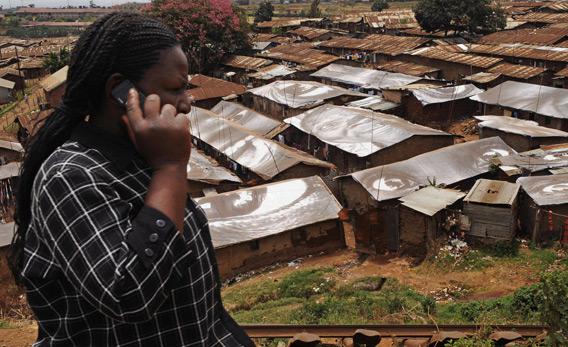For more on cellphone use around the world, see the Slate/New America Foundation map, “Which Countries Have the Most Mobile Phones?”
Entrepreneurs, businesses, NGOs, and governments exalt mobile technology as a game-changing tool to fight global poverty. But what if our eagerness to connect the world is inadvertently exacerbating the global economic divide?
In 2008, the New York Times reported that mobile phones may hold the key to ending global poverty altogether. The enthusiasm was—and is—understandable: From 2005 to 2010, cellphone use tripled in the developing world. According to the International Telecommunications Union, there are now almost 6 billion mobile-cellular subscriptions worldwide. Mobile penetration has reached 79 percent of the developing world. Multiple studies on information and communication technologies for development (ICT4D) have linked increased cellphone adoption with positive trends in economic and human development indicators, from gross domestic product to the Grameen Foundation’s Progress Out of Poverty Index.*
Despite the hype, a harsh new reality is unfolding. Take the case of the often glamorized M-PESA, Kenya’s popular mobile-phone-based payment and money transfer system. In only four years, M-PESA has grown to 14 million users. It now processes more transactions domestically in Kenya than Western Union does globally. The use of mobile phones to transfer money and manage personal finances has provided a speedier and more cost-effective delivery system for millions of Kenyans. The Economist reported in 2009 that Kenyan households using M-PESA saw their incomes increase—anywhere from 5 percent to as much as 30 percent—after beginning to use mobile banking. By the end of 2009, M-PESA had reached 65 percent of Kenyan households.
But there’s a downside to this program—and others like it—that’s too often ignored: These mobile money services do not effectively reach the poorest of the poor. In a 2010 study of M-PESA usage in Kenya, where mobile money penetration is greatest, 60 percent of the poorest quartile did not use the service. Part of the problem is access: Telecom companies have relatively little incentive to build out infrastructure, especially in poorer, rural markets.
Coverage is not the only problem. Mobile money services have a transaction fee structure that is prohibitive to those living below the poverty line—currently about 50 percent of the Kenyan population. These users are forced to pay remarkably high fees for their modest transactions. For example, a $1 M-PESA transfer carries a 12 percent fee; a $5 M-PESA transaction carries a nearly 8 percent fee. It may not sound like much, but for the poorest of the poor, this is a substantial financial drain.
These fee-based business models are geared toward maximizing revenue, which translates to a stunning level of resource extraction from poor communities. A 2007 report by Research ICT Africa examined income expenditures of 17 African countries and found that many of the poorest individuals studied were spending more than 16 percent of their entire income on mobile services. Obviously, for these constituencies, the current costs of connectivity are far too high. Yet while the technologies for dramatically lowering the cost of connectivity already exist, politicians and regulators have been unwilling to enact bold policies that would deploy innovative solutions and promote meaningful competition. For instance, regulators in Brazil under President Lula, have been willing to take on powerful financial interests; however, across most of the developing world, policymakers remain unwilling or unable to create pro-poor regulatory environments.
In the case of mobile connectivity, a rising tide does not lift all boats. As more people use and benefit from mobile services, the divide between adopters and those left out will grow exponentially. This creates a greater economic divide and leaves the poor further and further behind. In Kenya, M-PESA may, in fact, be driving a new wealth divide. While it’s helping many Kenyans access savings in a more efficient and safer way, M-PESA is also leaving a substantial portion of the nation’s poor in even more dire straits.
Now is the time for a radical shift in thinking about ICT4D and the digital divide. We must find practical and appropriate solutions to support truly universal low-cost mobile connectivity. This will require regulators and policymakers willing to fight the tough regulatory battles necessary in order to ensure that the poorest householders are able to truly harness the power of mobile connectivity. If we do not, we run the risk of helping many at the expense of doubly-disadvantaging substantial portions of the global populace.
This article arises from Future Tense, a collaboration among Arizona State University, the New America Foundation, and Slate. Future Tense explores the ways emerging technologies affect society, policy, and culture. To read more, visit the Future Tense blog and the Future Tense home page. You can also follow us on Twitter.
Jamie Zimmerman is the director of the Global Assets Project at the New America Foundation. Sascha Meinrath is the director of the Open Technology Initiative at the New America Foundation.
Correction, Feb. 10, 2012: This article originally misidentified the organization behind the Progress Out of Poverty Index. It is the Grameen Foundation, not the Grameen Bank. (Return to the corrected sentence.)
